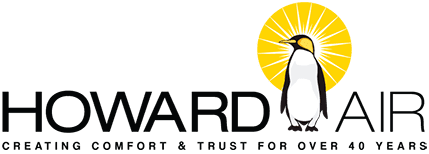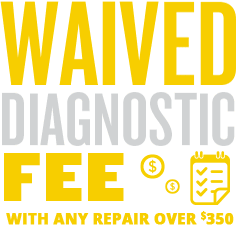F.A.Q.
Frequently Asked Questions
A: Howard Air was established in 1977. Kevin and Julie Howard are 2nd generation owners after purchasing the company from Kevin Howard’s father in the early 1990’s.
A: We service all major heating and air conditioning brands. Howard Air technicians undergo weekly training meetings and participate in industry certification programs preparing them to work on the various types and brands of equipment they will be tasked with working on.
A: Over the years we have serviced, sold, and installed all of the major brands available today. Due to this experience what we have found is that Trane and Carrier offer a superior product. Both brands represent the highest level of craftsmanship, warranties, and product support which we are proud to stand behind.
A: President, Kevin Howard is on the Better Business Bureau’s Air Conditioning Industry Advisory Committee. The committee is tasked with providing the Bureau with insight regarding the industry and to help form policies to ensure businesses within the industry are held to the highest standards of workmanship and customer service. Kevin Howard is proud to be among the select few Business owners in the valley with the experience and knowledge to participate in this committee.
A: No, we do not. We stick to what we know best, heating and air conditioning. We also specialize in ductwork and indoor air quality products. Many companies in our industry expand into other services unsuccessfully. It takes years of experience and trial and error to become an expert in your field. Many companies attempt to expand into fields they have no real experience in and without the proper expertise they typically offer subpar workmanship.
A: Yes, we are a certified contractor for both programs and participate in the replacement rebate programs. To be a part of these programs we are expected to maintain a high number of training hours through the Heat Pump Council, have several N.A.T.E. certified technicians on staff, and supply Manual J heat load calculations on every system we replace. APS offers an instant rebate at the time of purchase on select systems. SRP offers a mail in rebate per system depending on its efficiency rating.
A: All Howard Air staff are subject to and must pass a federal background check and drug screening prior to employment.
A: Yes, in appreciation for your referral anytime a client you referred purchases a new HVAC system, we will send you $100. We also send $25 for every service client referral as well.
A: Yes, Howard Air invests a considerable amount of time and money in training for its staff. Even office personnel receive product and industry specific training. A large number of field technicians and installers are N.A.T.E. certified, participate in training the Arizona Heat Pump Council, participate in weekly training meetings, and regularly receive factory training from our product distributors. We also have several BPI Certified Specialists on staff for ductwork and energy savings related services.
A: Yes, financing is available for all repairs, maintenance, accessories, and new equipment purchases. We partner with Wells Fargo to bring our clients the very best in financing options. Regular offers include 0% or low fixed interest rate options. All financing offers are based on approved credit by Wells Fargo Financial National Bank, an Equal Housing Lender. Special promotional offers are on select equipment and may change without notice. These offers cannot be combined with any other promotions, discounts, or offers.
A: Yes, we are proud to offer the industry’s first age based maintenance program. Say goodbye to gimmicky maintenance programs and say hello to a maintenance program with your best interest in mind. Howard Air has several preventative maintenance platforms available depending on the age and condition of your equipment. Our age based maintenance programs offer exclusive services, discounts, and priority scheduling.
A: Yes, it is essential for any heating and air conditioning company to perform a Manual J load calculation to determine the proper size of a replacement air conditioner. Every home and system is different and square footage is not the determining factor for sizing a unit. Sizing is determined by a number of factors including heating load, sensible cooling load, and latent cooling load all necessary to determine the home’s BTU demands which can then be related to the proper size of equipment.
A: Warranty options vary depending on the product or services rendered. Most part replacements come with a 1 year manufacturer guarantee and are backed by a 1 year workmanship guarantee. Most new equipment purchases will carry a minimum of a 10 year manufacturer parts, coil, and compressor warranty. Most new equipment sales come with a minimum of 1 year labor warranty but can be upgraded to 5, 10, or even a lifetime parts and labor warranty packages. All offers are based on the specific brand and available offers.
A: Hot or cold spots in the home are very common and most often are a result of the existing ductwork design called air balance issues. We offer a ductwork analysis to determine the right solution and recommendations can be made during an estimate to replace the current heating and cooling equipment.
A: Yes, we have several consultants on staff capable of making recommendations on how to improve the current ductwork. We also do residential new construction which includes design and installation of all ductwork and equipment. Howard Air has its own fabrication shop and does most of the related sheet metal and ductwork fabrication at its facility.
A: No, energy audits are a specialized service that deal with how well your home retains energy. We do recommend that you contact AZ Energy Efficient Home for a full energy analysis. They also participate in the APS and SRP energy audit rebate programs and can offer you a number of solutions to help make your home more efficient. They can be contacted at 480-471-0111.
A: We have a full custom metal fabrication shop complete with CNC plasma table for precision accuracy. All metal fabrication is done by Howard Air to guarantee proper sizing and air tight seals. We use heavy gauge sheet metal, double Insulated elbows (Inner layer), anti-microbial duct liner (outer layer), and hypoallergenic bubble wrap (Nasa technology) for improved sound dampening and R value.
A: No, our technicians are paid an hourly wage. This is one of the reasons you can trust the integrity of their recommendations. Companies that employee commissioned technicians are typically motivated to sell you things you do not need in order to earn a paycheck.
A: Yes, we have technicians on call 24 hours a day, 7 days a week, 365 days a year ensuring a prompt response to all of your service needs.
A: Quality maintenance will keep your system performing at peak condition and ensure maximum efficiency, life expectancy, and warranty compliance.
A: We recommend twice yearly. Once in the spring to ensure your cooling components are in good working order before the hot summer months, and once in the fall to ensure your heating components are in good working order before the cold winter months.
A: We will always wear protective shoe covers inside your home. We will also use drop clothes, floor covers, and other protective measures throughout the course of a new equipment installation. We also protect your home by putting all Howard Air staff through a comprehensive Federal background check and drug screening to ensure you and your home’s safety.
A: If your system is not working call us at 602-953-2766 and you will be connected to a live specialist 24/7/365.
A: Dirty filters are the leading cause of premature system failure. A clogged filter drastically reduces the efficiency and overall performance of your system. It’s important to change them frequently. Most one inch filters should be replaced once or twice a month depending on how quickly they become dirty. Four or five inch filters should be replaced every three to six months depending on how quickly they become dirty.
A: The efficiency of a air conditioner is rated by the Seasonal Energy Efficiency Ratio (SEER) which is defined by the Air Conditioning, Heating, and Refrigeration Institute. The higher the SEER rating the more energy efficient it is. The SEER rating of a unit is the cooling output during a typical cooling-season divided by the total electric energy input during the same period. SEER is the ratio of cooling in British thermal unit (BTU) to the energy consumed in watt-hours.
A: The Energy Efficiency Ratio (EER) of a cooling device is the ratio of output cooling energy (British thermal unit) to input electrical energy (watt-hours) at a given operating point. EER is generally calculated using a 95 °F outside temp and an inside (return air) temp of 80 °F and 50% relative humidity.
A: A heat pump is a mechanical-compression cycle refrigeration system that can be reversed to produce either hot or cold air. A compressor circulates refrigerant that absorbs and releases heat as it travels between the indoor and outdoor units. You will find heat pump systems available in split systems with an outdoor heat pump and indoor air handler or as package systems designed for rooftop installations.
A: The EPA recommends having your ducts cleaned at least once every 10 years. Asthmatics and people with allergies should have it done more often. Air ducts can be a resting place for allergens, dust, mold, viruses, and more. As your AC system circulates air it continuously reintroduces these elements into the air you breathe. Having your duct clean you will drastically reduce these elements inside your home.
A: A warranty only covers regular wear and tear items that break or are operating outside of the manufacturer’s specifications, without proper system maintenance you risk voiding your warranty. Taking a proactive approach to maintenance will avoid costly breakdowns, keep the system working at peak efficiency, and maximize the life of your system.
A: Contrary to popular belief, there is no rule of thumb for sizing a system to a home. Depending upon the construction of your home, one (1) ton of air conditioning can cool anywhere from 300 to 800 square feet of home. The only way to ensure the size of the system you purchase will be large enough to cool your home, but not any larger than you need, is to have your home’s individual heating and cooling needs evaluated by a licensed professional.
A: The most important thing you can do is clean and replace your filters frequently. Also, a system heats and cools more evenly when the blower is in the “on” position. The blower provides constant air movement throughout the home, and allows for better filtration. Finally, shades, drapes, shutters, or screens should be installed on windows that are exposed to extreme sunlight.
A: No. A larger system with more capacity delivers less comfort and costs more to operate. An air conditioner is at its least efficient when first turning on. A system with too much capacity will run in numerous short cycles, turning on and off repeatedly, therefore causing it to be less efficient. Also keep in mind that an air conditioner only removes humidity when it’s running, so a system with shorter run cycles doesn’t remove humidity from the air very well.
A: There is no exact answer for how long your system should run during each cycle. The average air conditioner is sized to remove the heat from your home as fast as it comes in. Therefore, ideally on a 110° day the system should be able to keep up with the incoming heat, but not gain on it and be able to turn off. The cooler it is below 110°, the more the system will cycle on and off.
A: Every time your system starts up it will use a lot of electricity and not produce much cooling. Usually, a system that is too small to cool the home is more economical to run but delivers less comfort. Even though it runs nonstop, it will usually consume less power than a larger system that cycles on and off. As a rule of thumb, a unit that is either on or off is less expensive than one cycling on and off.
A: The air temperature your system produces depends on the temperature of the air going into the system. Generally, the air produced should be 18°-20° below what enters the system. So if the air entering the system is 80°, the air exiting should be about 60°-62°. However, that only works on a system that has been running at least 15 minutes on a warm, dry day with a home that is about 80° inside. On a mild day, with an indoor temperature in the low 70′s, or during humid conditions, the air coming out may only be 15°-17° cooler than what enters.
A: Obviously, the time of year becomes a big factor for desired temperature settings. In the summer months the average temperature setting is 78°-80°, in the winter 70°-72° seems to be the most common setting. Remember, when leaving your house; try to avoid drastic temperature changes. Do not set your temperature back more than 5°; this will cause your unit to work harder to achieve the desired temperature setting.
A: Different programmable thermostats offer many different features. However, because they are electronic they are all more accurate and efficient than thermostats that contain mercury. With programmable thermostats you can control the temperature in your home at different times of day without ever touching your thermostat, and because everything is automatic you will never forget to change the setting on your own.














